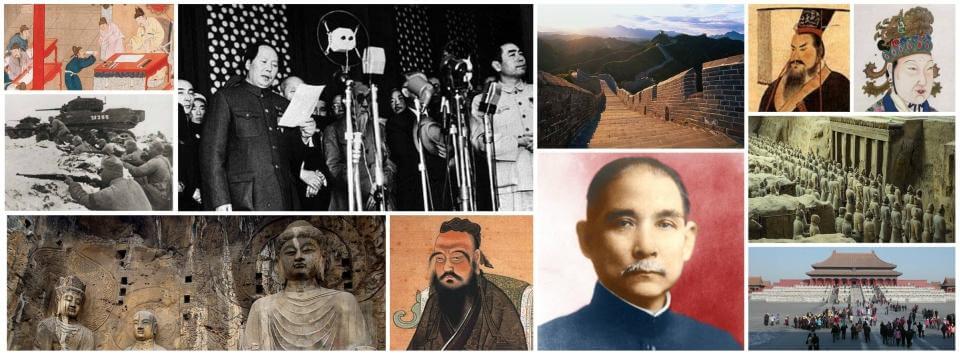
The Great Wall at Shanhaiguan
The information contained here are subject to change. Chinese History Digest is not responsible or liable if any changes should occur.
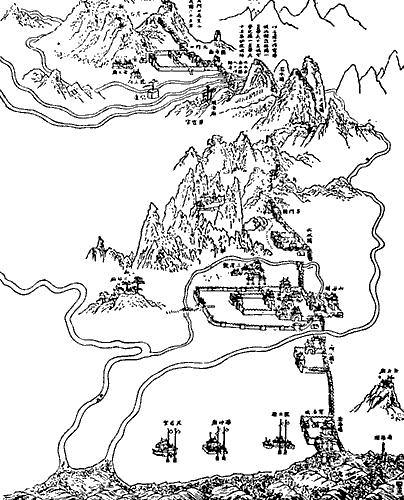 old illustration of a map of ShanhaiguanThe town of Shanhaiguan (a district of Qinhuangdao in Hebei province) is famous throughout China for its Great Wall sites that have withstood the centuries more or less intact. It is also the location of the Shanhaiguan Great Wall Museum which is one of only three museums in China that are dedicated to the Great Wall. The three Great Wall sites in Shanhaiguan are the First Pass Under Heaven, Old Dragon's Head (Laolongtou) and the Jiaoshan Great Wall. During imperial times, these three sites were a part of an elaborate defense system that protected access to the strategically important Shanhai Pass.
old illustration of a map of ShanhaiguanThe town of Shanhaiguan (a district of Qinhuangdao in Hebei province) is famous throughout China for its Great Wall sites that have withstood the centuries more or less intact. It is also the location of the Shanhaiguan Great Wall Museum which is one of only three museums in China that are dedicated to the Great Wall. The three Great Wall sites in Shanhaiguan are the First Pass Under Heaven, Old Dragon's Head (Laolongtou) and the Jiaoshan Great Wall. During imperial times, these three sites were a part of an elaborate defense system that protected access to the strategically important Shanhai Pass.
Shanhaiguan literally means "mountain-sea-pass" and that name was chosen after the present pass was built in AD 1381. It stands south of the Yan Mountains and north of the Bohai Sea. The narrow passage in between once was China's most heavily guarded frontier pass. Travellers from the north that wanted to enter China then had to come through the First Pass under Heaven. The area near the sea was protected by the fortress at Laolongtou and the Jiaoshan Great Wall protected the area where the wall climbs the first mountain on its way west.
Luckily, these historic Great Wall sites have survived the centuries without significant damage and are now popular tourist destinations that receive significant numbers of visitors from China and around the world each day. Even though visitor numbers for the Great Wall sites in Shanhaiguan are much lower than for the Badaling section of the Great Wall outside Beijing, it is still advisable for foreign tourists to plan their visit outside Chinese holiday periods.
When visiting Shanhaiguan, it might be best to first go to the Shanhaiguan Great Wall Museum. There, you will get a good overview of all the different fortifications that once were a part of the Great Wall system in the Shanhaiguan area. The wall once played a vital role in protecting China from the attacks of nomadic northern peoples such as the Manchus. Everyone in China today knows Shanhaiguan for the role it played in the fall of the Ming dynasty and the establishment of the Qing dynasty.
In the spring of AD 1644, Beijing had fallen to a rebel army under the leadership of Li Zicheng. The Chongzhen Emperor had already committed suicide by hanging himself from a tree at the capital's Jingshan Park. Rather than stand aside to let the country be run by peasant rebels, the Ming general Wu Sangui reluctantly entered into an alliance with the Manchus in the north. At dawn on the 27th of May, he ordered the opening of the gates of the Shanhai Pass for the Manchu army and officially surrendered to them. Wu Sangui's troops then helped the Manchu army to annihilate Li Zicheng's rebel forces. Instead of restoring the Ming dynasty then though, the Manchus moved the capital of their Qing dynasty empire to Beijing and took over control of all of China in the years that followed.
How to travel to Shanhaiguan?
| Airport: | Qinhuangdao Beidaihe Airport (BPE) |
| Train Station: | Shanhaiguan Railway Station, Qinhuangdao Railway Station, Beidaihe Railway Station |
Shanhaiguan Great Wall Museum
Opening Hours
8am - 5pm
Entrance Ticket Prices
Free Admission
The Shanhaiguan Great Wall Museum is located in a traditional-style building just a short walk south of the First Pass Under Heaven. When it was opened in 1991, it became the first Great Wall Museum in all of China. In the years since, two other Great Wall Museums have been opened in Jiayuguan in Gansu province and Badaling near Beijing.
The museum in Shanhaiguan showcases the wall's architectural beauty and provides insights into various military, cultural and organizational aspects. A special emphasis is put on explaining the military function of the various Great Wall fortifications at the Shanhaiguan Pass. The exhibits at the museum consist of pictures and cultural relics that are distributed across six differently-themed halls. These are the Preface Hall, History Hall, Construction Hall, Military Hall, Culture Hall and Shanhaiguan Great Wall Hall.
A statue of General Xu Da stands at the entrance of the Preface Hall. He directed the construction of the fortifications at Shanhaiguan Pass in AD 1381. The story of how Xu Da had the Shanhaiguan fortress and its wall extensions built is vividly illustrated with pictures and maps and accompanied by a brief history of the Pass.
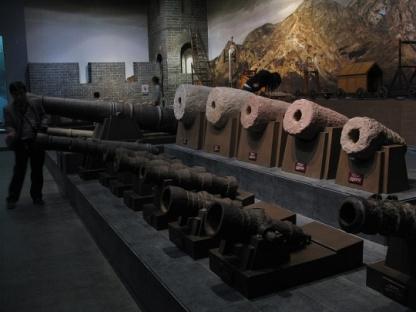 old cannons on display at the Shanhaiguan Great Wall MuseumThe long history of China's Great Wall, from the Warring States Period to the Ming dynasty, is shown through pictures, illustrations, maps and cultural relics in the History Hall of the Shanhaiguan Great Wall Museum. However, the first exhibit you will see when entering the hall is a model of the Banpo Trench. It was built by the neolithic people of the Yangshao culture about 7000 years ago as a defense against floods and wild animals and is regarded as the earliest form of China's Great Wall. To learn more about the ancient village of Banpo and our human ancestors that once lived there, you might consider visiting the Banpo Museum in Xi'an.
old cannons on display at the Shanhaiguan Great Wall MuseumThe long history of China's Great Wall, from the Warring States Period to the Ming dynasty, is shown through pictures, illustrations, maps and cultural relics in the History Hall of the Shanhaiguan Great Wall Museum. However, the first exhibit you will see when entering the hall is a model of the Banpo Trench. It was built by the neolithic people of the Yangshao culture about 7000 years ago as a defense against floods and wild animals and is regarded as the earliest form of China's Great Wall. To learn more about the ancient village of Banpo and our human ancestors that once lived there, you might consider visiting the Banpo Museum in Xi'an.
In the Construction Hall, you will see bricks, tiles and some of the tools that were used to build the Great Wall more than 400 years ago. You will also learn more about various issues that were important in the building process: how a building site was selected and the layout and structure of the fortifications were planned, how a steady supply of labor was procured, how the different building materials were used . . . etc.
From today's perspective, it is perhaps all too easy to regard the Great Wall as just a monumental boundary landmark. That however overlooks its primary military function which was to protect China from invasion/raids by the nomadic peoples of the north. At the museum's Military Hall, visitors will see exhibits such as cannons, scaling ladders and stone mines that serve as a vivid reminder of the Great Wall's sometimes violent past.
The complete defensive system of the Great Wall at the Shanhaiguan Pass was made up of passes, walls, watch towers and beacon towers. To help visitors to visualize it in its entirety, a miniature model complete with lights and sound stands in the Shanhaiguan Great Wall Hall. The model shows the wall's path from where it stretches out into the Bohai Sea at Laolongtou all the way to Jiumenkou about 15km north of Shanghaiguan.
At the Culture Hall of the Shanhaiguan Great Wall Museum, you will see how the wall culturally fits into its environment. To illustrate some of the local conditions and customs, about 80 pictures that were taken at scenic spots in the vicinity of the wall are shown. These photographs of temples, palaces, murals and pavilions might give visitors some ideas about other places to visit in the Shanhaiguan area. To get a first overview of the visitable tourist sites in Shanhaiguan, check out this detailed map!
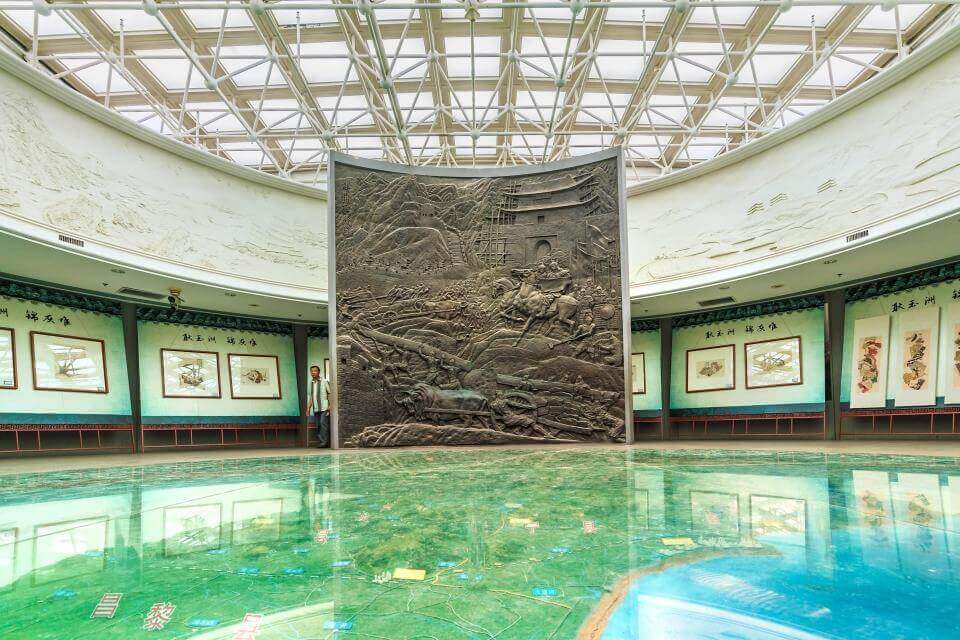 inside the Shanhaiguan Great Wall Hall at the Shanhaiguan Great Wall Museum
inside the Shanhaiguan Great Wall Hall at the Shanhaiguan Great Wall Museum
How to get to the Shanhaiguan Great Wall Museum?
| Address: | Shanhaiguan Great Wall Museum, Diyiguan Road, Shanhaiguan, Hebei province, China |
| Tel.Nr.: | +86 335 5051 313 |
| Bus: | bus lines: 25, 34 |
The First Pass Under Heaven
Opening Hours
May - October: 7am - 6pm
November - April: 7.30am - 5pm
Entrance Ticket Prices
May - October: 40 yuan
November - April: 15 yuan
The First Pass Under Heaven is the name under which the east gate of the Great Wall fortifications at the Shanhai Pass is most commonly known. It is also known as the Zhendong Gate or Zhendong Tower. Forming a square around the town of Shanhaiguan, the fortifications with their 14-meter-high and 7-meter-wide walls are still an impressive sight today.
The first protective structures were built here during the time of the Ming dynasty in AD 1381. Expansion to a fortified military city then occurred during the late 16th century. The Shanhai Pass was of strategic importance then because the area to the east of it was out of jurisdiction of the imperial Chinese government. The task of the soldiers that were stationed here was to protect China's central plain from incursions by nomadic tribes from the north.
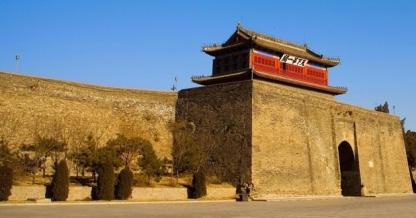 Zhendong Tower on top of a gate in the Great Wall (a.k.a. the First Pass Under Heaven)Back then, there was a gate in the middle of each of the four sides of the enclosure. Ying'en Gate stood in the west, Wangyang Gate in the south, Weiyuan Gate in the north and Zhendong Gate in the east. Facing outward towards enemy territory, the eastern side of the Shanhai Pass was the most heavily fortified with a total of five towers. In addition to the Zhendong Gate, these were the Weiyuan Hall, Linlu Tower, Muying Tower and Jingbian Tower. These five towers that were protecting the border were then considered as the "Five Tigers". A deep and wide moat that could only be crossed on drawbridges surrounded the eastern, southern and northern wall and a barbican stood in front of each of the four gates. Only the Zhendong Gate at the eastern side still stands today. A wide road led from each of the gates to the Bell and Drum Tower at the center of the enclosure.
Zhendong Tower on top of a gate in the Great Wall (a.k.a. the First Pass Under Heaven)Back then, there was a gate in the middle of each of the four sides of the enclosure. Ying'en Gate stood in the west, Wangyang Gate in the south, Weiyuan Gate in the north and Zhendong Gate in the east. Facing outward towards enemy territory, the eastern side of the Shanhai Pass was the most heavily fortified with a total of five towers. In addition to the Zhendong Gate, these were the Weiyuan Hall, Linlu Tower, Muying Tower and Jingbian Tower. These five towers that were protecting the border were then considered as the "Five Tigers". A deep and wide moat that could only be crossed on drawbridges surrounded the eastern, southern and northern wall and a barbican stood in front of each of the four gates. Only the Zhendong Gate at the eastern side still stands today. A wide road led from each of the gates to the Bell and Drum Tower at the center of the enclosure.
The Zhendong Tower is a two-storey gate tower out of bricks and wood that sits atop a rectangular platform. It was named the First Pass Under Heaven as a way to underscore its important strategic position. You can see that name inscribed in Chinese Hanzi characters (it reads "Tian Xia Di Yi Guan" in pinyin) on a large tablet that hangs under the eave of the tower since AD 1472. The tablet you currently see hanging there was created in 1920 however. The calligraphic style of its characters imitates the original inscription by a Ming dynasty official.
To see the original tablet as well as a first copy that was made in 1879, you will have to go inside the Zhendong Tower. Looking out through one of the 68 small arrow windows inside will perhaps make you feel like an archer of the imperial Ming army for a second. For the best views in all directions and the opportunity to take splendid photos, climb up to the second floor of the tower.
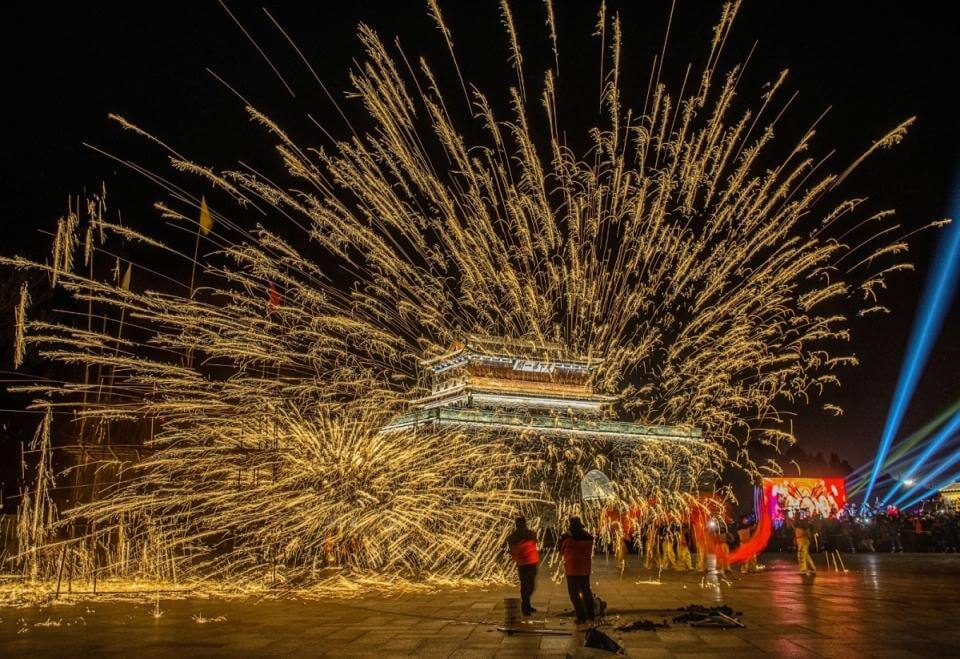 Chinese new year celebrations with traditional molten iron fireworks in front of Zhendong Gate in Shanhaiguan
Chinese new year celebrations with traditional molten iron fireworks in front of Zhendong Gate in Shanhaiguan
How to get to Shanhaiguan's First Pass Under Heaven?
| Address: | First Pass Under Heaven, Qijialou Hutong, Shanhaiguan, Hebei province, China |
| Tel.Nr.: | +86 335 5051 957 |
| Bus: | Tian Xia Di Yi Guan Station (bus lines: 25, 33) |
Old Dragon's Head (Laolongtou)
Opening Hours
May - October: 7am - 6pm
November - April: 7.30am - 5pm
Entrance Ticket Prices
May - October: 50 yuan
November - April: 20 yuan
Old Dragon's Head (Laolongtou) is famous throughout China as the place where the Great Wall meets the sea. The Laolongtou Scenic Area is located about 5km southeast of the town of Shanhaiguan. The main parts of the section of the Great Wall that you will see here were built in AD 1381. That includes the Ninghai Fortress area that you will see first when you enter this popular tourist site through the North Gate. This is where the Chinese soldiers that once defended the Great Wall lived, trained and fought to repel invading armies. You will see some typical structures of a military garrison here such as a training ground, commander's office and commanding platform, military camp and even some temples.
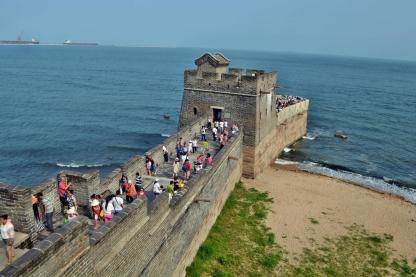 the Estuary Stone Great Wall that reaches out into the sea at Old Dragon's HeadThe two-storey Chenghai Pavilion is undoubtedly the most important structure of Old Dragon's Head. It stands at the southeastern corner of the Ninghai Fortress and is the tallest structure at the site. Five different emperors of the Qing dynasty stopped here a total of twelve times on their way to the Shenyang Imperial Palace in order to worship their ancestors. The poems and other inscriptions that were made in stone tablets by the emperors during these visits are on display at the Chenghai Pavilion. From the second floor of this pavilion, you will also enjoy the best views of the surrounding area.
the Estuary Stone Great Wall that reaches out into the sea at Old Dragon's HeadThe two-storey Chenghai Pavilion is undoubtedly the most important structure of Old Dragon's Head. It stands at the southeastern corner of the Ninghai Fortress and is the tallest structure at the site. Five different emperors of the Qing dynasty stopped here a total of twelve times on their way to the Shenyang Imperial Palace in order to worship their ancestors. The poems and other inscriptions that were made in stone tablets by the emperors during these visits are on display at the Chenghai Pavilion. From the second floor of this pavilion, you will also enjoy the best views of the surrounding area.
There is a lot more to see at the Laolongtou Scenic Area. Between the sea and the Chenghai Pavilion stands the Nanhaikou Pass Tower. It leads to the Jinglu Beacon Tower and the Estuary Stone Great Wall. The Jinglu Beacon Tower is the only beacon tower that was built to overlook the sea. It was added to the wall in AD 1565. The construction of the Estuary Stone Great Wall then followed in AD 1579. This is the eastern end of the Great Wall and the most famous part of its Laolongtou section. The wall here reaches out into the Bohai Sea for 22.4 meters. With a little bit of fantasy, you can regard the wall that is crisscrossing the hilly Shanhaiguan landscape as a coiled stone dragon. The Estuary Stone Great Wall then represents the dragon's nose at it is plowing through the waves. This fantastical interpretation is reflected in the name Laolongtou (Old Dragon's Head) of this section of the wall.
About 350 meters west of the Estuary Stone Wall stands the Sea God Temple behind a large memorial archway. Surrounded by water on three sides, its two temple halls are dedicated to the Goddess of Heaven and the Sea God. People traditionally came here to pray for a good harvest and/or a safe sea voyage. Behind the temple and reaching out into the sea you will find the Sea-Viewing Pavilion. When the weather is misty, the Laolongtou Great Wall will appear only indistinct from here as if it was a mysterious gateway to a fairyland.
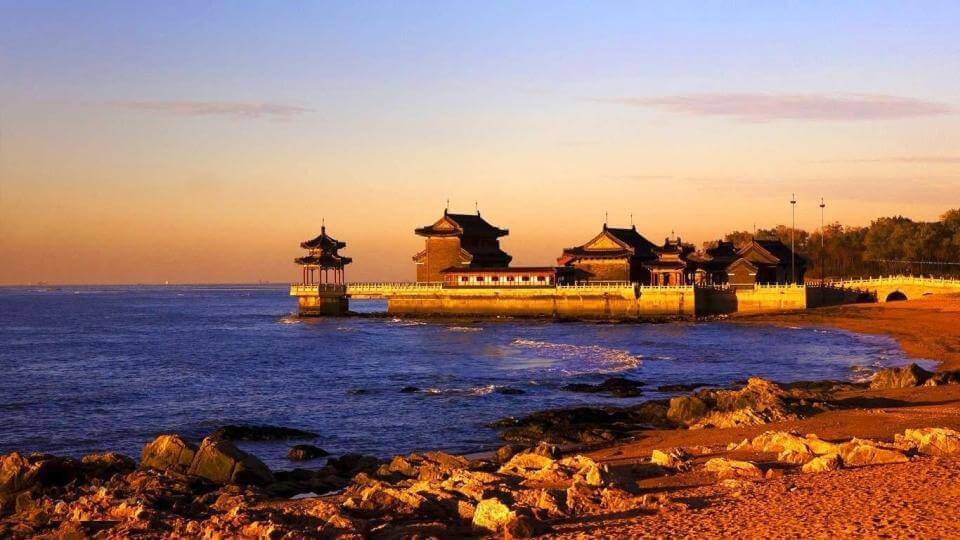 the Sea God Temple west of the Estuary Stone Wall at the Laolongtou Scenic Area
the Sea God Temple west of the Estuary Stone Wall at the Laolongtou Scenic Area
How to get to the Laolongtou section of the Great Wall?
| Address: | Old Dragon's Head (Laolongtou), Haikou Road, Shanhaiguan, Hebei province, China |
| Tel.Nr.: | +86 335 5152 996 |
| Bus: | Take bus line 25 from the Shanhaiguan Railway Station to the Laolongtou Intersection North, then walk 200m to scenic area OR take bus line 13 from the "First Pass Under Heaven" (Tianxia Diyi Guan) to Laolongtou |
Jiaoshan Great Wall
Opening Hours
5am - 6.30pm
Entrance Ticket Prices
April - November: 30 yuan
December - March: 10 yuan
The Jiaoshan Great Wall was built more than 600 years ago during the early period of the Ming dynasty. It is located about 3km north of Shanhaiguan at the point where the Great Wall climbs the Jiaoshan Mountain, the first mountain it encounters on its long path to the west. Most visitors get here by taxi or bus. However, you could also just walk out of the north gate of Shanhaiguan's city wall and simply follow the Great Wall north. The wall is interrupted by two roads on its way north to the Jiaoshan section though. You will know that you have arrived there when you see a large gate in the approximate shape of the Chinese character "山". Considering the detours you would have to make in order to cross the two roads and the relative difficulty in climbing this unrepaired part of the Great Wall, it would probably take an intrepid hiker about 1.5 hours for the 3km walk to the Jiaoshan Scenic Area.
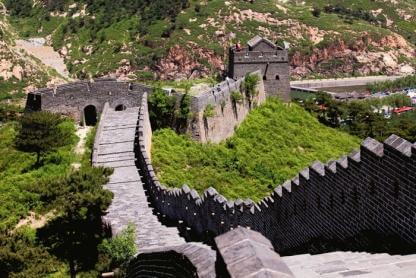 partial view of the renovated lower section of the Jiaoshan Great WallThe Jiaoshan Great Wall consists of a renovated section and an original section. The renovated section is the first part when entering this scenic area. It starts at Hanmen Pass and continues for about 1.5km via the No.1 and No. 2 Watchtower to the No. 3 Watchtower. Even though that doesn't seem to be a very far distance, keep in mind that the wall is mostly moving uphill here, oftentimes quite steeply. You will find iron staircases at some of the steepest sections, which make the climb a bit easier. Better be especially careful if you choose to climb up the iron ladders that lead to some of the watchtowers! However, not all parts of the renovated section of the Jiaoshan Great Wall are steep and narrow, so there are also some wide and flat parts. Altogether, you should plan about 1.5 hours for the hike from Hanmen Pass up to the No. 3 Watchtower.
partial view of the renovated lower section of the Jiaoshan Great WallThe Jiaoshan Great Wall consists of a renovated section and an original section. The renovated section is the first part when entering this scenic area. It starts at Hanmen Pass and continues for about 1.5km via the No.1 and No. 2 Watchtower to the No. 3 Watchtower. Even though that doesn't seem to be a very far distance, keep in mind that the wall is mostly moving uphill here, oftentimes quite steeply. You will find iron staircases at some of the steepest sections, which make the climb a bit easier. Better be especially careful if you choose to climb up the iron ladders that lead to some of the watchtowers! However, not all parts of the renovated section of the Jiaoshan Great Wall are steep and narrow, so there are also some wide and flat parts. Altogether, you should plan about 1.5 hours for the hike from Hanmen Pass up to the No. 3 Watchtower.
Another much easier way to reach the top of the renovated section is by cable car (20 yuan for a roundtrip). When riding the cable car, you will certainly enjoy the panoramic view of the Shanghaiguan area with the Bohai Sea in the misty distance. An even better option might be to ride the cable car up (15 yuan for a one-way trip) and then hike on the wall back down.
Some really adventurous souls might be inclined to continue climbing up the unrenovated original section of the wall that starts just behind the No. 3 Watchtower. In order to do that, you would have to climb over a wall that is cemented to that last tower (at your own risk and peril!). After a very difficult climb of about an hour, you would then reach Daping Peak, the main peak of the Jiaoshan Mountain. The marvelous view from there along the full length of the Jiaoshan Great Wall would certainly be worth that effort. You would also see Yansai Lake in the west, Changshou Mountain in the northeast, the town of Shanhaiguan in the south and perhaps even Old Dragon's Head (Laolongtou) shrouded in the mist of the Bohai Sea behind it. Energized from the view at the top of Daping Peak, you could continue your hike on the wall for another hour further east until you come to the Sandaoguan Pass.
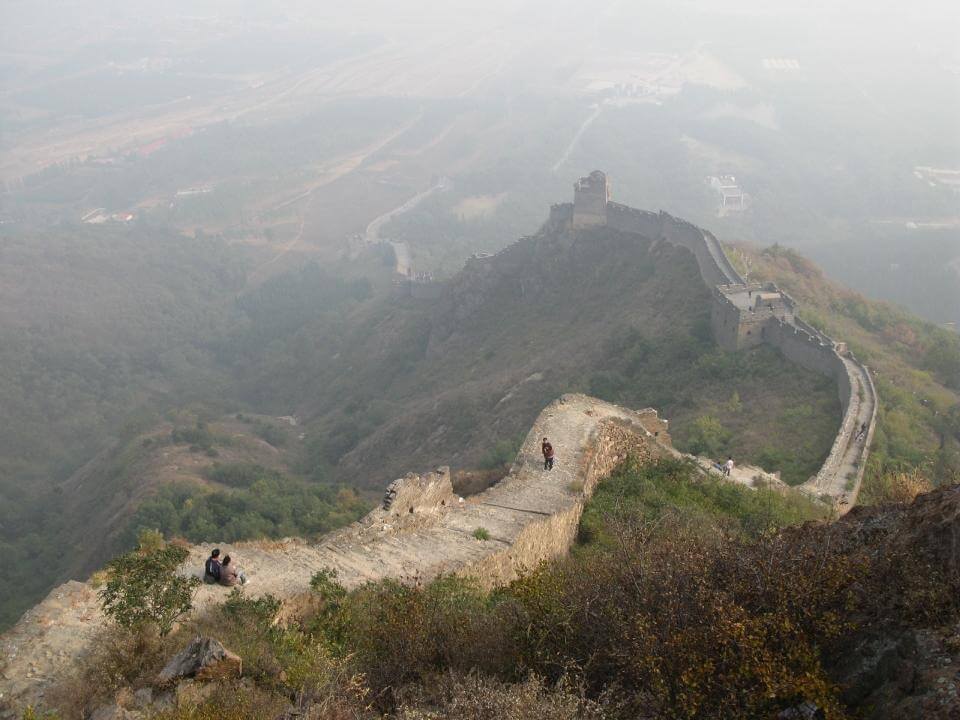 the unrenovated upper section of the Jiaoshan Great Wall
the unrenovated upper section of the Jiaoshan Great Wall
How to get to the Jiaoshan section of the Great Wall?
| Address: | Jiaoshan Great Wall, Jiaoshan Road, Shanhaiguan, Hebei province, China |
| Tel.Nr.: | +86 335 505 2861 |
| Bus: | From the Shanhaiguan Railway Station or the First Pass Under Heaven, you can take the "Zhuan 5" bus line to the Jiaoshan Scenic Area |
On the following Google map, you can see the location of Shanhaiguan's Great Wall sites (the blue icons) and our recommended hotel nearby, the Richmond Hotel (the yellow hotel bed icon). Zoom out of the map to see the location of the Shangri-La Hotel Qinhuangdao, our recommended hotel in the nearby city of Qinhuangdao. Further below on this page, you can read a review of the services and amenities of both of these hotels. In case you are planning a trip to China, you could support this website by using the provided affiliate links to check prices and book your hotel accomodation!
You can book hotels in China with both of our affiliate partners Agoda and Trip.com. No matter whether you choose Agoda or Trip.com, you will find many offers on each of these platforms that will allow you to make a risk-free booking with the possibility of free cancellation until a clearly stated date and time, sometimes as late as on the intended date of arrival. However, some deals require prepayment and don't permit cancellation without fees. In that case, the incurred cancellation fees are clearly stated.
When following an Agoda link, the search results will show you prices, availability and special offers for your chosen dates with the recommended hotel in the top search position as well as for other hotels in the same area. Links to Trip.com will take you to the specific hotel webpage where you can then search for availability, prices and special deals with your chosen dates.
The provided information was thoroughly researched from various hotel booking websites. Chinese History Digest is not responsible if any information regarding the provided services and amenities might have changed.
Recommended Hotel in Shanhaiguan
The Richmond Hotel that is reviewed below is located in Shanhaiguan itself. It is one of the few hotels in that small town that are allowed to provide lodging to non-Chinese nationals. In addition to the links to Agoda that are used in the review below, this hotel is also available for booking on Trip.com by following this link.
Richmond Hotel
 Shanhaiguan is a small town, so there are not so many accomodation options available there (especially no 4 or 5-star hotels). Many of the smaller hotels in Shanhaiguan don't have the necessary government license to be allowed to provide lodging to non-Chinese nationals. The Richmond Hotel is one of the few hotels that can provide lodging to foreigners in Shanhaiguan. It is located in the Shanhaiguan Area for Development which makes it easy to find when coming to Shanhaiguan by taxi, about 2.7km away from Old Dragon's Head (about 15 yuan by taxi from the hotel). The First Pass Under Heaven (5.4km away) and the Jiaoshan Great Wall (7.0km) are both also just a short taxi ride away from this hotel. Reaching the Richmond Hotel from the Shanhaiguan Railway Station takes about 10 minutes by car and even the 35-minute drive from the Qinhuangdao Railway Station is still affordable by taxi. The hotel can arrange car and bicycle rentals for its guests and secured free parking is available. Convenient access to the neighborhoods around the hotel is provided through a free shuttle service.
Shanhaiguan is a small town, so there are not so many accomodation options available there (especially no 4 or 5-star hotels). Many of the smaller hotels in Shanhaiguan don't have the necessary government license to be allowed to provide lodging to non-Chinese nationals. The Richmond Hotel is one of the few hotels that can provide lodging to foreigners in Shanhaiguan. It is located in the Shanhaiguan Area for Development which makes it easy to find when coming to Shanhaiguan by taxi, about 2.7km away from Old Dragon's Head (about 15 yuan by taxi from the hotel). The First Pass Under Heaven (5.4km away) and the Jiaoshan Great Wall (7.0km) are both also just a short taxi ride away from this hotel. Reaching the Richmond Hotel from the Shanhaiguan Railway Station takes about 10 minutes by car and even the 35-minute drive from the Qinhuangdao Railway Station is still affordable by taxi. The hotel can arrange car and bicycle rentals for its guests and secured free parking is available. Convenient access to the neighborhoods around the hotel is provided through a free shuttle service.
The rooms of the Richmond Hotel are fairly large and family rooms are available for travellers with kids. All rooms are air-conditioned and equipped with a flatscreen TV. Free Wi-Fi and luggage storage are available. Smoking is only permitted in certain designated areas of the hotel. To provide for the culinary needs of its guests, there is a buffet restaurant as well as a snack bar on the hotel's premises. However, self-catering also is a valid option for guests since there are many small shops in the hotel's vicinity.
1.7 miles away
Check availability & prices!Recommended Hotel in Qinhuangdao
The Shangri-La Hotel Qinhuangdao that is reviewed below is a 5-star luxury seaside hotel. It is located right next to the beach at the much bigger city of Qinhuangdao (about 10 miles from Shanhaiguan). In addition to the links to Agoda that are used in the review below, this hotel is also available for booking on Trip.com by following this link.
Shangri-La Hotel Qinhuangdao
 Tourists that plan to visit Shanhaiguan on a day trip from Qinhuangdao (about 10 miles away) will find a lot more accomodation options in that big city. The Shangri-La Hotel Qinhuangdao is perhaps the best hotel there. It is a 5-star hotel that was opened in 2015 at Golden Dream Bay with many of its rooms directly overlooking the Bohai Sea. The Qinhuangdao Olympic Sports Center Stadium lies just 1.3km away from the hotel and Qinhuangdao's city center (7.2km away) and railway station (9km away) can typically be reached within 25 minutes by taxi. The Shangri-La Hotel Qinhuangdao offers a shuttle service and can also arrange taxis as well as car and bicycle rentals. Free parking is available. Travel time from the hotel to the Qinhuangdao Beidaihe Airport is about 40 minutes and airport transfer can be requested and booked (for an extra fee) when making the hotel booking online.
Tourists that plan to visit Shanhaiguan on a day trip from Qinhuangdao (about 10 miles away) will find a lot more accomodation options in that big city. The Shangri-La Hotel Qinhuangdao is perhaps the best hotel there. It is a 5-star hotel that was opened in 2015 at Golden Dream Bay with many of its rooms directly overlooking the Bohai Sea. The Qinhuangdao Olympic Sports Center Stadium lies just 1.3km away from the hotel and Qinhuangdao's city center (7.2km away) and railway station (9km away) can typically be reached within 25 minutes by taxi. The Shangri-La Hotel Qinhuangdao offers a shuttle service and can also arrange taxis as well as car and bicycle rentals. Free parking is available. Travel time from the hotel to the Qinhuangdao Beidaihe Airport is about 40 minutes and airport transfer can be requested and booked (for an extra fee) when making the hotel booking online.
All rooms of the Shangri-La Hotel Qinhuangdao are air-conditioned and equipped with a refrigerator, minibar, safe and flatscreen TV. Free Wi-Fi is available and breakfast (continental and buffet) is generally included in the room rate (158 yuan if not included). Smoking is however only permitted in certain designated areas of the hotel. Laundry service (including dry cleaning) and luggage storage are available. There are two restaurants (à la carte local Chinese and seafood dishes + buffet) at the hotel as well as a bar and coffee shop. Hotel guests have numerous choices when it comes to being physically active including an indoor swimming pool, a modern fitness center and a room for playing table tennis. The hotel's charming private gardens provide direct access to the beach and a sauna, spa, steamroom and massages are available for relaxation.
13.7 miles away
Check availability & prices!
